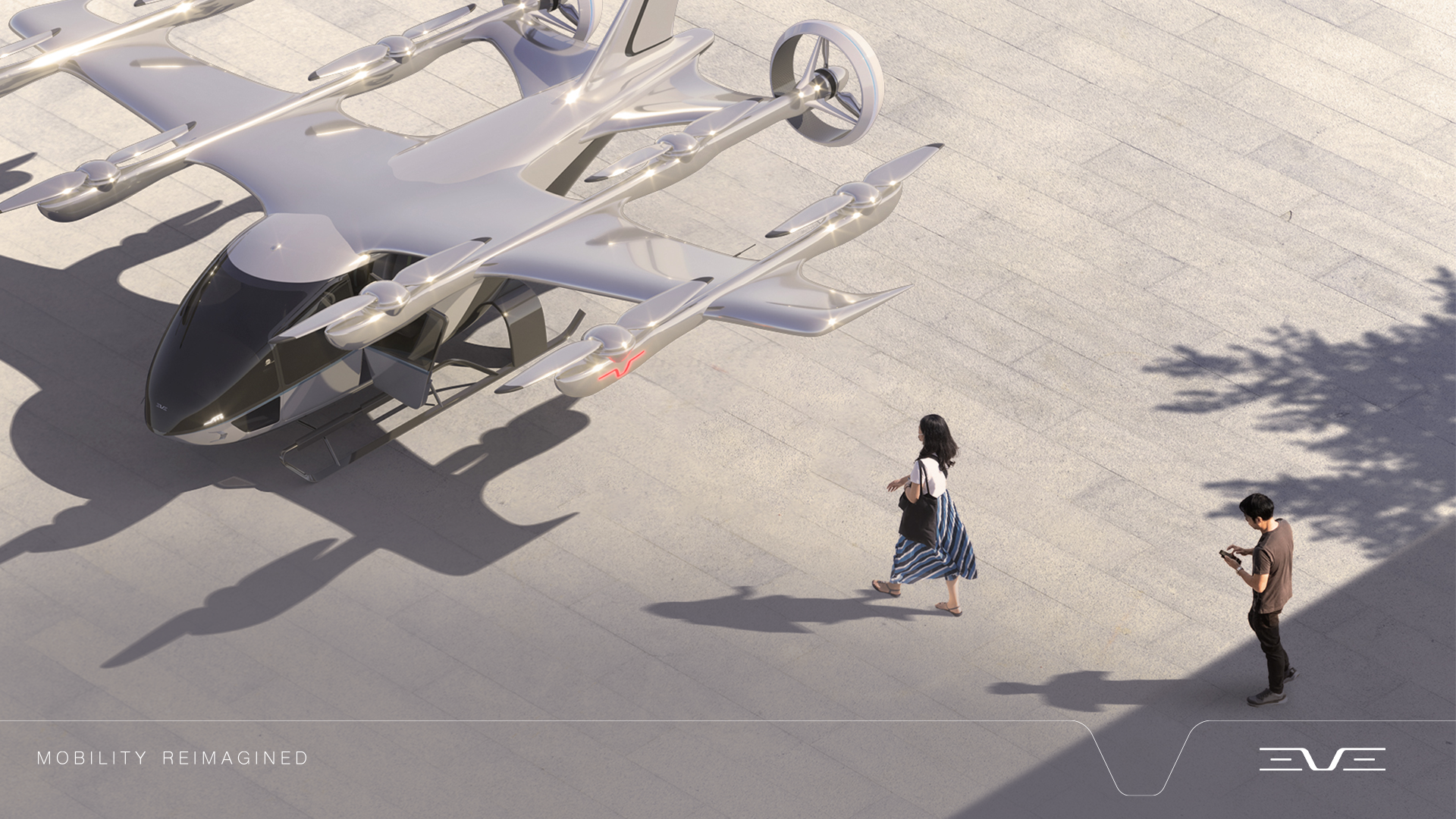Integrated solutions and new infrastructure for urban air mobility are set to transform the air traffic management industry.

Airspace Article

“Urban ATM will support the integrated operation of UAM vehicles and other airspace users in low-level airspace to enable the optimised performance and safety of UAM operations, driving towards autonomy, optimising the performance of operations will include consideration of all ICAO key performance areas, including safety, security, the environment, cost effectiveness, flexibility, flight efficiency, capacity, predictability, access and equity, and global interoperability.”
Rob Weaver
Urban ATM Global Business Development Leader of Eve

“Urban ATM services are an evolution of traditional ATM concepts, with an initial focus on piloted urban air mobility (UAM) operations, it will integrate with Unmanned Aircraft System Traffic Management (UTM) services, which are primarily focused on UAS operations.”
Rob Weaver
Urban ATM Global Business Development Leader of Eve


A conformance and information management solution that ensures environmental compliance obligations are met, and community-relevant information can be provided.
Urban Authority
A multitude of companies are involved in this emerging – and potentially lucrative – sector. Eve Air Mobility recently signed a Letter of Intent with Ferrovial Vertiports, for example, their seventh such agreement. The aim is to explore the use of Eve’s Urban Air Traffic Management (Urban ATM) software solution to support the safe and reliable operation of vertiports and eVTOLs.
Ferrovial Vertiports has already announced that it will develop a network of more than 10 vertiports across Florida in the United States and a network of 25 vertiports across the United Kingdom. It is studying other markets in the United States and worldwide. Eve’s Urban ATM software, meanwhile, will enable the integration of all airspace users in the urban environment in a safe and efficient manner.
“Urban ATM services are an evolution of traditional ATM concepts, with an initial focus on piloted urban air mobility (UAM) operations,” says Rob Weaver, Urban ATM Global Business Development Leader of Eve. “It will integrate with Unmanned Aircraft System Traffic Management (UTM) services, which are primarily focused on UAS operations.”
Emerging sector
Eve is developing a portfolio of technical solutions that can add value to different stakeholders within the UAM ecosystem:
An airspace and flow management solution that optimises airspace use and network management.
ANSP/UAM service provider
A vertiport automation airside support solution that coordinates resource availability with multiple operators.
Vertiport Operator
A UAM flight coordination solution that maximizes efficiency for UAM flight operations.
Fleet Operator
Eve sees three sequential horizons:
As to the timeline for these developments, Rodriguez anticipates ground transport gradually shifting to the sky beginning with local cargo being carried from out-of-town locations into city suburbs. In the late 2020s, air taxis could take to the skies in rural and costal locations – away from traffic and large populations – and in the next decade passengers will routinely be taking automated air taxis from an airport to their downtown hotel.
Eve has a similar outlook. “This evolution of operations is essential to ensure the right services are implemented at the right time and to support the advancement from one horizon to the next,” says Weaver.
Future developments
Eve has also signed a LOI with Bluenest, another vertiport developer. Jose Rodriguez, Business Development Manager, Bluenest, explains this essential infrastructure will come in various sizes but have a relatively small footprint, simple designs and integrate other transport modes as much as possible. In fact, Bluenest already has more than 30 vertiport designs to cater for different users and environments.
More of a concern, according to Rodriguez, will be securing the long-term investment and resources necessary to turn aspirations into reality. The paradigm shift is enormous and new infrastructure and operational systems won’t come cheap. Vertiports will likely charge a modest take-off and landing fee, though the business model has yet to be finalised.
Nevertheless, progress is inevitable and will be for the better, believes Rodriguez. Innovative air mobility will become vital to businesses and national GDP as well as the quality of life for communities.
“We are agnostic,” Rodriguez adds. “Much like an airport, we will cater to air vehicles from multiple manufacturers and for multiple uses and we will take advantage of all the expertise they have to offer. Our infrastructure is the key to tackling important challenges in congested cities and remote areas by connecting people and goods.
“A lot of research, standardisation, regulation, experimentation and development is still ahead, but we are confident that vertiports will become as important as airports, train stations and logistical hubs,” he continues. “We will collaborate as much as necessary to ensure a sustainable and exciting future. There is no limit to ideas and innovation and unmanned aviation will become a reality.”
Long-term investment

Airspace Article
Air traffic management (ATM) is changing rapidly, especially at low levels. In the not too distant future, airspace in urban areas and around airports will include such new users as drones or uncrewed aircraft systems (UAS) and electric vertical take-off and landing vehicles (eVTOLs).
Likely piloted at first, eVTOLs carrying passengers and cargo across the urban landscape will eventually mature to become an uncrewed, automated sector operating at large scale. Vertiports – airports for eVTOLs and other low-level airspace users – will spring up throughout cities to serve the demand.
Urban air mobility (UAM) vehicles, which encompasses all low-level flights, will have a range of performance characteristics. Rotor-borne lift systems will operate alongside vehicles with vectored thrust and those with both rotor-borne and wing-borne lift systems. The latter will generally perform longer range missions as wing-borne lift typically requires less energy per unit distance.
Safely separating these new vehicles will be paramount. And so eVTOL operations will be equipped with detect-and-avoid systems and a Mode S transponder and Automatic Dependent Surveillance-Broadcast (ADS-B) to the required standard. High-precision cooperative surveillance will also be necessary as pilots’ ability to detect conflicts through see-and-avoid becomes more difficult as traffic increases. When piloted, there will, of course, be voice communication though some manufacturers are focusing development on remotely piloted and autonomous aircraft.
There will be some operational requirements in common with helicopters, but not all. The limitations for wind speeds and directions for take-off and landing will be different, for example. UAM operations are likely to be susceptible to the impact of weather and structure-induced turbulence. Visual Flight Rules (VFR) are therefore likely to be quickly superseded by Instrument Meteorological Conditions (IMC). In addition, operations at low level over built-up areas will have to consider the frequent erection of temporary obstructions, such as construction cranes or signage.
UAM vehicles are expected to operate primarily between 500–1,000 ft as this offers both good energy consumption and segregation from other aircraft. Nevertheless, UAM vehicles will need to integrate with other airspace users on occasion, including helicopters and drones, especially during approach and departure and around vertiport locations.
UAM operations

Horizon 3
Mix of piloted and uncrewed UAM vehicle operations.
Integration of UTM and Urban ATM concepts.
Horizon 2
UAM vehicle operations where current ATM procedures and technologies are insufficient to support the demand for operations.
New ATM solutions will be needed to enable the UAM industry to scale.
Horizon 1
Piloted UAM vehicle initial operations using conventional ATM procedures and technology.
Implementation of existing ATM concepts, such as visual flight rules.
New vertiport and fleet operations planning, information sharing, flow management, and situational awareness solutions.

Integrated solutions and new infrastructure for urban air mobility are set to transform the air traffic management industry.
Read full article

Airspace Article

Horizon 2
UAM vehicle operations where current ATM procedures and technologies are insufficient to support the demand for operations.
New ATM solutions will be needed to enable the UAM industry to scale.
Rob Weaver
Urban ATM Global Business Development Leader of Eve
“Urban ATM services are an evolution of traditional ATM concepts, with an initial focus on piloted urban air mobility (UAM) operations, it will integrate with Unmanned Aircraft System Traffic Management (UTM) services, which are primarily focused on UAS operations.”
Piloted UAM vehicle initial operations using conventional ATM procedures and technology.
Implementation of existing ATM concepts, such as visual flight rules.
New vertiport and fleet operations planning, information sharing, flow management, and situational awareness solutions.
Horizon 1
Mix of piloted and uncrewed UAM vehicle operations.
Integration of UTM and Urban ATM concepts.
Horizon 3
Other important lessons from the pandemic include:
A conformance and information management solution that ensures environmental compliance obligations are met, and community-relevant information can be provided.
Urban Authority
An airspace and flow management solution that optimises airspace use and network management.
ANSP/UAM service provider
A vertiport automation airside support solution that coordinates resource availability with multiple operators.
Vertiport Operator
Other important lessons from the pandemic include:
A multitude of companies are involved in this emerging – and potentially lucrative – sector. Eve Air Mobility recently signed a Letter of Intent with Ferrovial Vertiports, for example, their seventh such agreement. The aim is to explore the use of Eve’s Urban Air Traffic Management (Urban ATM) software solution to support the safe and reliable operation of vertiports and eVTOLs.
Ferrovial Vertiports has already announced that it will develop a network of more than 10 vertiports across Florida in the United States and a network of 25 vertiports across the United Kingdom. It is studying other markets in the United States and worldwide. Eve’s Urban ATM software, meanwhile, will enable the integration of all airspace users in the urban environment in a safe and efficient manner.
“Urban ATM services are an evolution of traditional ATM concepts, with an initial focus on piloted urban air mobility (UAM) operations,” says Rob Weaver, Urban ATM Global Business Development Leader of Eve. “It will integrate with Unmanned Aircraft System Traffic Management (UTM) services, which are primarily focused on UAS operations.”
Emerging sector
A UAM flight coordination solution that maximizes efficiency for UAM flight operations.
Fleet Operator
As to the timeline for these developments, Rodriguez anticipates ground transport gradually shifting to the sky beginning with local cargo being carried from out-of-town locations into city suburbs. In the late 2020s, air taxis could take to the skies in rural and costal locations – away from traffic and large populations – and in the next decade passengers will routinely be taking automated air taxis from an airport to their downtown hotel.
Eve has a similar outlook. “This evolution of operations is essential to ensure the right services are implemented at the right time and to support the advancement from one horizon to the next,” says Weaver.
Future developments
Eve has also signed a LOI with Bluenest, another vertiport developer. Jose Rodriguez, Business Development Manager, Bluenest, explains this essential infrastructure will come in various sizes but have a relatively small footprint, simple designs and integrate other transport modes as much as possible. In fact, Bluenest already has more than 30 vertiport designs to cater for different users and environments.
More of a concern, according to Rodriguez, will be securing the long-term investment and resources necessary to turn aspirations into reality. The paradigm shift is enormous and new infrastructure and operational systems won’t come cheap. Vertiports will likely charge a modest take-off and landing fee, though the business model has yet to be finalised.
Nevertheless, progress is inevitable and will be for the better, believes Rodriguez. Innovative air mobility will become vital to businesses and national GDP as well as the quality of life for communities.
“We are agnostic,” Rodriguez adds. “Much like an airport, we will cater to air vehicles from multiple manufacturers and for multiple uses and we will take advantage of all the expertise they have to offer. Our infrastructure is the key to tackling important challenges in congested cities and remote areas by connecting people and goods.
“A lot of research, standardisation, regulation, experimentation and development is still ahead, but we are confident that vertiports will become as important as airports, train stations and logistical hubs,” he continues. “We will collaborate as much as necessary to ensure a sustainable and exciting future. There is no limit to ideas and innovation and unmanned aviation will become a reality.”
Long-term investment
Air traffic management (ATM) is changing rapidly, especially at low levels. In the not too distant future, airspace in urban areas and around airports will include such new users as drones or uncrewed aircraft systems (UAS) and electric vertical take-off and landing vehicles (eVTOLs).
Likely piloted at first, eVTOLs carrying passengers and cargo across the urban landscape will eventually mature to become an uncrewed, automated sector operating at large scale. Vertiports – airports for eVTOLs and other low-level airspace users – will spring up throughout cities to serve the demand.
Urban air mobility (UAM) vehicles, which encompasses all low-level flights, will have a range of performance characteristics. Rotor-borne lift systems will operate alongside vehicles with vectored thrust and those with both rotor-borne and wing-borne lift systems. The latter will generally perform longer range missions as wing-borne lift typically requires less energy per unit distance.
Safely separating these new vehicles will be paramount. And so eVTOL operations will be equipped with detect-and-avoid systems and a Mode S transponder and Automatic Dependent Surveillance-Broadcast (ADS-B) to the required standard. High-precision cooperative surveillance will also be necessary as pilots’ ability to detect conflicts through see-and-avoid becomes more difficult as traffic increases. When piloted, there will, of course, be voice communication though some manufacturers are focusing development on remotely piloted and autonomous aircraft.
There will be some operational requirements in common with helicopters, but not all. The limitations for wind speeds and directions for take-off and landing will be different, for example. UAM operations are likely to be susceptible to the impact of weather and structure-induced turbulence. Visual Flight Rules (VFR) are therefore likely to be quickly superseded by Instrument Meteorological Conditions (IMC). In addition, operations at low level over built-up areas will have to consider the frequent erection of temporary obstructions, such as construction cranes or signage.
UAM vehicles are expected to operate primarily between 500–1,000 ft as this offers both good energy consumption and segregation from other aircraft. Nevertheless, UAM vehicles will need to integrate with other airspace users on occasion, including helicopters and drones, especially during approach and departure and around vertiport locations.
UAM operations

Airspace Article
